Company of Heroes 3's North African operation is a classic RTS campaign
The second campaign switches settings, throws in a new faction and drops the turn-based map.
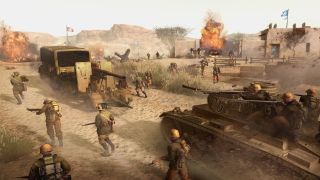
Years ago, I found myself bouncing around in the back of a 4x4 in the desert outside of Dubai, following the route an upcoming rally would be taking. I felt a bit worse for wear after a day of speeding over dunes and through wadis, and it would be a while before I'd be able to comfortably sit down again, but I came away with a newfound appreciation of the golden expanse—for its big, open spaces that really let vehicles rip; for its hidden dangers that can halt drivers in their tracks; and for the surprising diversity and sudden, dramatic changes in terrain.
These qualities, which gave me such a memorable experience when I was 12, also make the desert a compelling setting for an RTS. This becomes very clear when you watch a horde of tanks barrelling through the dunes, blasting their gargantuan guns at infantry desperately trying to find some rare desert cover. And thanks to Company of Heroes 3's North African operation, you're going to be seeing a lot of that.
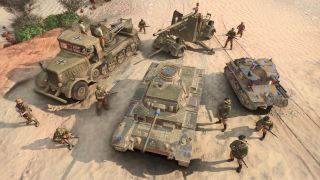
We've known that Relic's latest RTS would be heading to North Africa since it was announced, but what shape this trip to a new theatre of war would take, exactly, was a mystery—until now. Company of Heroes 3's North African operation is a return to the more familiar campaigns of its predecessors, with a more straightforward chain of missions and no turn-based portions. It's all about those explosive RTS brawls.
"In the Italian dynamic campaign, what we're doing is allowing players to forge their own story and their own path," senior mission designer David Milne explains. "It's an open campaign map where players are able to choose what missions and in what order they do them. The North African operation is a linear story. So the players are going to go through and play each mission one after the other and experience that whole story start to finish as we tell it to them."
While we'll be playing as the Allies in Italy, the North African operation is played from the perspective of the Deutsche Afrika Korps. This heavily-mechanised German army is distinct from the Wehrmacht forces fighting in Europe and arrives on the scene after the Axis have been pushed back by the British. When the campaign begins, however, the tables have turned and the DAK are on the offensive.
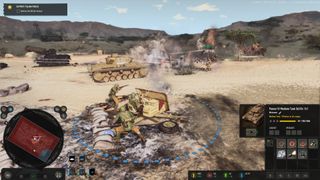
The faction's units and tactics are a good match for desert warfare and players who just want to throw as many vehicles into the mix as possible, but there's something undeniably uncomfortable about playing a faction of Europeans as they invade Africa, especially when they're also Nazis. German factions are also playable in skirmishes, but playing a campaign with them in the driving seat is quite a different proposition, which has informed how the team approached the construction of the operation's narrative.
We don't want to glorify or make Rommel a hero here in any kind of way, even though you will be playing from the German perspective.
Ryan Bourret, Relic
Relic has not tried to soften the DAK and paint them as sympathetic. This is a foreign power terrorising people who have been dragged into a war they want nothing to do with. They are, in movie parlance, the 'bad guys', and thus not a group you're going to be rooting for.
The biggest gaming news, reviews and hardware deals
Keep up to date with the most important stories and the best deals, as picked by the PC Gamer team.
"It's a difficult line to ride," says narrative and audio producer Ryan Bourret. "We don't want to glorify or make Rommel a hero here in any kind of way, even though you will be playing from the German perspective."
Rebel Rebel
So while we'll be following the advance of the DAK, we'll simultaneously follow the story of Selema, a 17-year-old Jewish Berber girl, showing us the impact that the conflict between the Axis and Allies had on the people living in North Africa. Relic's used regional voice actors, cultural consultants and historical accounts to craft both its battles and the narrative running through them, so while it's fun to watch tanks duke it out in the desert, the studio is hoping it will still come across as respectful, giving a voice to more than just the invaders.
"Ultimately Selema's story is a story of survival, and a story of resistance," Bourret adds. And it's a common story. It's a story that pops up whenever war happens. It's what the people usually end up having to do. A story of rebellion."
As the monstrous DAK war machine roars across North Africa, we'll encounter several major historical battles, from Ajdabiya to El Alamein. "These were really important victories for the DAK," says Milne. "The way that we approached them was really by doing a bunch of research. We're reading accounts that we can find, we're watching documentaries, we're reading books, we're, in some cases—in the case of Tobruk—going to Google Earth, because you can still see some of the trench lines in satellite photos."
The first mission takes place near Ajdabiya, with the DAK coming in to support their Italian allies. Within seconds I was trying to use smoke to hide from British tanks before getting stuck into an intense ongoing battle. And all I had with me were some Panzergrenadiers and a pair of stalwart Panzer IIIs.
"I like that little tank," says Milne. "It's punchy. It's fast, you can put a squad of troops on it, you can give it some upgrades, and it's an awesome mainline tank. And it looks great with dust all over it." He's right—it's a cracking vehicle that's useful in most situations. And it does—like most of the tanks I saw—look fantastic with a bit of wear and tear, some dust here, some battle damage there.
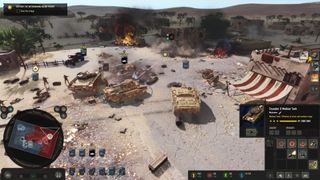
With the tank-riding mechanic, tanks can serve as makeshift troop transports, with soldiers hitching a ride on top of the behemoths. This allows you to keep your forces together and moving at the same pace even when you've not got access to dedicated vehicles. Towing, meanwhile, lets you hitch big guns to vehicles, allowing you to bring them with you as you move to a new part of the battlefield—if they don't get blown up first.
Not everything that gets turned into a smouldering husk is gone for good, mind. The highlight of my fight across the desert was undoubtedly the repair vehicle, and I took advantage of its very specific skills frequently. As you may have guessed, it's used to fix up busted vehicles, which naturally makes it a bit of an MVP. Not only can it repair damage, it can effectively resurrect vehicles that have been taken out of commission. But its real trick, the thing that makes it really special, is its ability to repair enemy vehicles, making them work for your side.
All DAK infantry can perform repairs, though they aren't nearly as good at it as the dedicated mechanics hanging out on the back of the repair vehicles. They're all going to be pretty busy, too, because Company of Heroes 3 revels in destruction.
Appetite for Destruction
"With the North African operation, we're bringing all of the elements of traditional Company of Heroes destruction into that theatre," says group technical director Ian Thompson, "so we can see elements of deformation of terrain, the buildings being destroyed, and while those buildings are being destroyed soldiers are still trying to find combat slots to fire from … Destructible buildings, destructible foliage, all those things combine together with the vehicles and units moving around for a more enriched destruction environment."
The level of devastation you see after a big fight is horrific but impressive. The big fires, smoking wrecks and demolished buildings will catch your eye first, but what brings these scenes to life are the miniscule details, like the dirt and battle damage on the tanks—all dynamic—and the countless bits of debris scattered everywhere, some of it identifiable, some of it not, but all of it telling the story of the battle that was fought there.
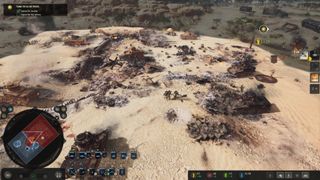
I was the one causing most of this destruction, but even in this first mission, and even with the Brits ostensibly on the retreat, there are plenty of opportunities to lose big chunks of your force. Moving past a derelict train, feeling confident, I was quickly punished by infantry hiding in the carriages behind me, immediately followed by a tank assault. It was a dastardly trap. I survived, though, and continued pushing forwards.
Destructible buildings, destructible foliage, all those things combine together with the vehicles and units moving around for a more enriched destruction environment.
Ian Thompson, Relic
While most of the British assaults in this mission are scripted, once the fight begins you can start to see evidence of the AI's reactivity and tactics. Given that the mission is designed to teach you how to fight, the Brits here are not the canniest or most deadly of adversaries, but every unit has big vulnerabilities and things that can counter it, so the battle can turn in an instant.
"We've really done a lot of work with the AI to make it [better at reacting to the enemy]," says Thompson. "In traditional Company of Heroes development, ones I've experienced in the past, AI was something we did last. We would build the multiplayer game, then we'd build the AI, but we knew we needed to build it much earlier this time, so we've been able to have much more experience with the AI and so it's a much more robust player of the game."
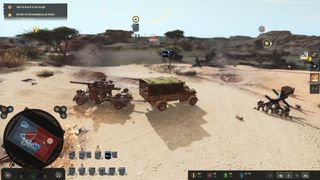
After a few more tense battles I finally reached the town where I'd have my climactic confrontation with the enemy, at least in this mission. It's a classic Company of Heroes scenario where, after clearing the town, you need to lie in wait for a counter attack. There's just enough time to garrison your troops in buildings and set up defences along the road. I kept the main route through the town pretty clear, but off to the side, waiting to strike, was a horde of tanks and anti-tank guns. When the Brits arrived, the party started, shaking the town to its very foundations. The Brits were defeated, but there was hardly a building left standing.
Even though this final battle has a familiar setup, it still feels distinct from the urban brawls in Europe. In Italy, the narrow streets, tall buildings and frequent changes in elevation are a nightmare for vehicles, but make them infantry playgrounds. In North Africa, the streets are wider and there's less elevation—though all the flat roofs do give infantry another place to attack from—so it's much easier to take advantage of a mechanised force.
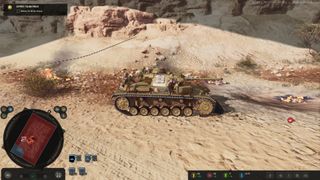
The North African maps are in part defined by their sparsity. The settlements are less urbanised, and they're surrounded by a lot more empty space, with rolling dunes that'll give you plenty of room to manoeuvre your vehicles and get into massive tank battles. This is why things like tank riding are so handy: troops are so much more vulnerable, with larger distances to travel and a lot less cover. But this isn't to say there's no diversity. There are trench networks, camps, rocky areas that thwart tanks, minefields and set pieces like the aforementioned derailed train.
After chasing off the Brits, I was struck by how different the mission felt compared to the ones I fought in Italy last year, as well as those from the previous games. The campaign structure might evoke classic Company of Heroes, but fighting in North Africa feels like a properly new experience. And it's one you can see for yourself right now. The mission I played is available to everyone who's signed up to the CoH-development programme, which you can do on the community site. For the rest of the campaign, you'll need to wait until Company of Heroes 3 launches on November 17.

Fraser is the UK online editor and has actually met The Internet in person. With over a decade of experience, he's been around the block a few times, serving as a freelancer, news editor and prolific reviewer. Strategy games have been a 30-year-long obsession, from tiny RTSs to sprawling political sims, and he never turns down the chance to rave about Total War or Crusader Kings. He's also been known to set up shop in the latest MMO and likes to wind down with an endlessly deep, systemic RPG. These days, when he's not editing, he can usually be found writing features that are 1,000 words too long or talking about his dog.
Most Popular

